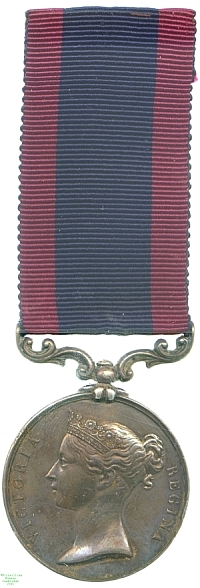
Obverse, a bust of Queen Victoria

Reverse, Victory standing facing left holding a wreath, with war spoils at her feet; the exergue bears the inscription "FEROZESHUHUR"

Obverse, a bust of Queen Victoria |

Reverse, Victory standing facing left holding a wreath, with war spoils at her feet; the exergue bears the inscription "FEROZESHUHUR" |
In the early nineteenth century the Sikh Kingdom of the Punjab bordered the possessions of the British East India Company, and so a succession crisis from 1839 onwards that caused persistent mutinies among the Sikh soldiery caused the Company to build up its forces on the border at Ferozepur. Diplomatic relations rapidly deteriorated and on 11 December 1845 the Sikh army crossed the Sutlej River in a pre-emptive attack on the British. Initially the British feared imminent defeat, as they were outnumbered and undersupplied, but the Sikhs did not press home their advantage before the British managed to reinforce their position, whereafter they drove the Sikhs back in a series of decisive battles. The subsequent treaty of Lahore, of 22 February 1846, forced the Sikh Kingdom to surrender Kashmir to the East India Company and established a British resident in Lahore; it also resulted in the gift of the famous Koh-i-Noor diamond to Queen Victoria. Sikh resentment of the British intrusion resulted in a new outbreak of war in 1847.
In April 1846 the East India Company instituted a medal for participation in the war of 1845-1846. Four issues were made, differing in the name of the battle inscribed in the reverse exergue; the recipient was given that whose inscription was the first of those in which he had fought. Bars were issued for his battle honours subsequent to this. This example was awarded to Private Francis Greenway of the 29th Regiment, who fought in an inconclusive but mutually costly attack on the main Sikh position at Ferozeshah soon after the outbreak of war, on 21 December 1845. Lester Watson purchased the medal at some point before 1928.